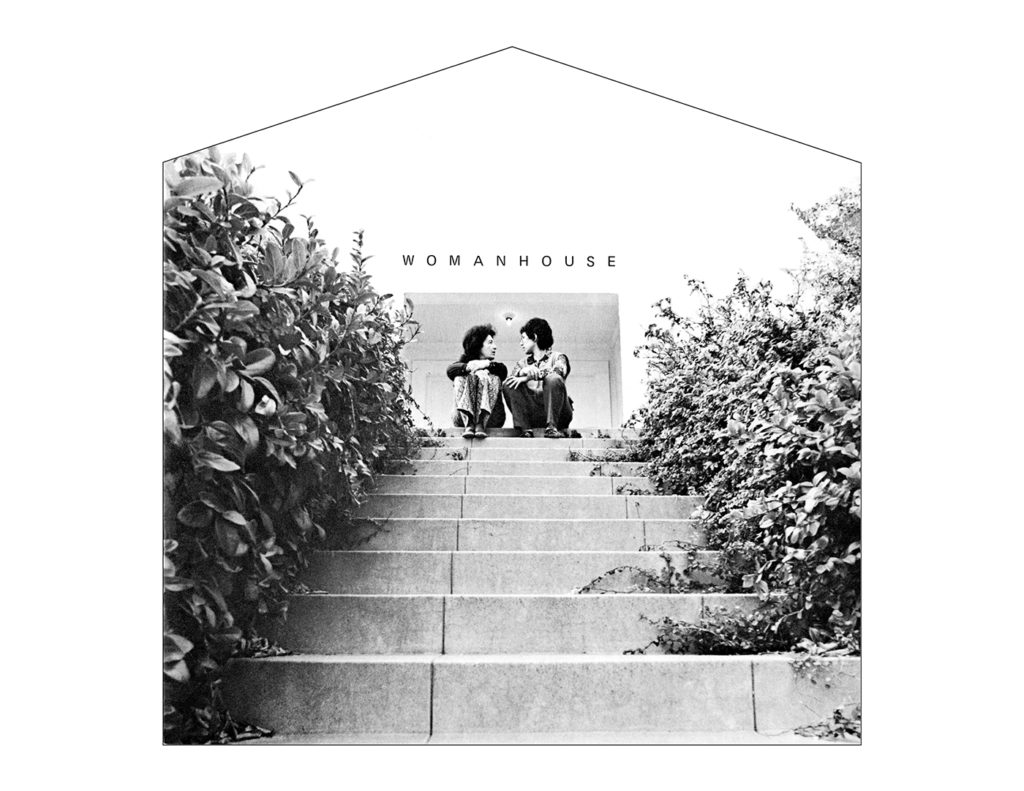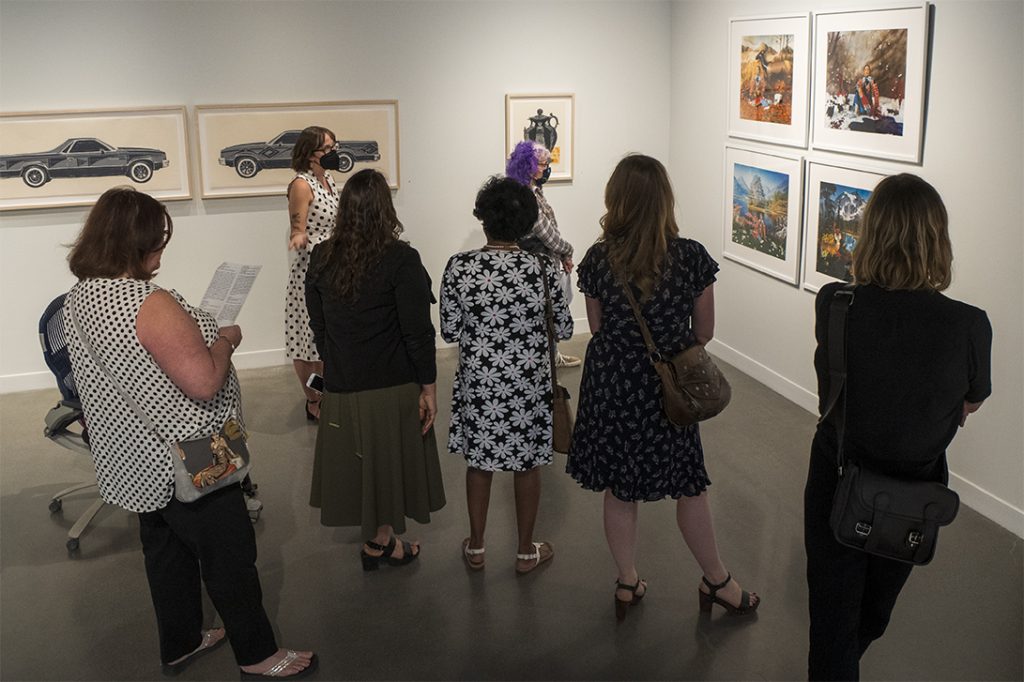

Judy Chicago and the 2021 Judy Chicago Art Education Award Winner Courtney Uldrich at Establishing Our Own Art History: The Influence of Judy Chicago at the University Art Museum at NMSU, April 2022. Photo © Donald Woodman/ARS, NY
In her October 11th, 2021, review of my retrospective at the de Young Museum, art critic Jori Finkel wrote; “…Womanhouse was so important that Gloria Steinem has said that she could divide her life into before and after she saw it. Could it be time for a recreation?” One reason that Through the Flower established the Judy Chicago Art Education Award (Funded by MaryRoss Taylor) was because – even though women artists have made strides towards equality – it is still rare for their influence on other artists and/or the culture to be fully acknowledged. Thus, Jori’s asking why Womanhouse has never been re-created. Another example, MaryRoss recently sent me an article about the performance of an opera by Ethel Smyth at the Houston Grand Opera. She was completely forgotten until we honored her in The Dinner Party, which MaryRoss pointed out in her accompanying note but the article did not.
I could cite an abundance of examples but don’t have the time or space to do so. Rather, I would ask readers to think about how many contemporary works of art actually move viewers in the way, for instance, The Dinner Party does. So much so that people around the world make pilgrimages to the Brooklyn Museum (where it is permanently housed) and decades earlier, organized and pressured museums or established their own spaces so that they could SEE it. Had it been up to the art world, it would have been consigned to the dump as a ‘relic of the 1970s’ (I was actually told in the 1990s that several schools were teaching it as such. See Jane Gerhard’s book, “Judy Chicago and the Power of Popular Feminism”).

Judy Chicago, Womanhouse catalog cover from Womanhouse, 1972, Photo courtesy of Through the Flower archives housed at the Penn State University Archives
We recently posted a “Dazed” article on my Instagram that emphasized the radicality of Womanhouse. Not only did it introduce new subject matter and materials, it also directly challenged many aspects of contemporary art, primarily the way in which the construct of masculinity is embedded into the art that is valued – by both male and female artists. Patriarchy is manifested in a myriad of ways; not only in the assault on women’s reproductive rights, lack of equality in the workplace and ongoing sexual harassment and abuse but also – more subtly – in the ways in which artists are encouraged to ‘code’ their work. What I mean is that even though many artists express personal subject matter in their work, the art world rewards those who do so in ways that cannot be perceived by most viewers. This is a reflection of the construct of masculinity which devalues and represses (in men) the overt expression of emotion.
In contrast, the art in the original Womanhouse, the At Home project that Donald and I facilitated at Western Kentucky University that took place on the 30th anniversary of the original project, and the currently developing Wo/Manhouse presents openly content based work whose meaning will be clear, as my own work tries to be, which might explain why it was marginalized for so many decades. For those unfamiliar with Womanhouse, let me say that it was an undertaking that grew out of the first Feminist Art Program that I initiated in 1970 at what is now California State University, Fresno and then moved to Cal Arts where the artist, Miriam Schapiro, and I team taught. In the Fall of 1971, we embarked on a project; transforming the rooms of a dilapidated mansion near downtown L.A. into the first major feminist art installation. Over the month the exhibition was open, it drew over 10,000 visitors and Johanna Demetrakas made a film about the project that was seen all over the world. Moreover, there have been dozens of Womanhouse inspired projects but very little research on its demonstrable historic impact.
Just recently, there was an exhibition in Los Angeles at the Anat Ebgi Gallery that included some of the original participants. And in mid-June, WOMXHOUSE Detroit: The Art of Being Female in America Today will premiere, featuring women artists of color. These are only two examples of projects here and around the world based on Womanhouse. But there has been little serious scholarship on the legacy of Womanhouse or the At Home project.
(Left) Cock and Cunt Play, performed by Faith Wilding and Jan Lester at Womanhouse, 1972. Photo courtesy of Through the Flower Archives. (Middle) Judy Chicago and Nancy Youdelman demonstrate Cock and Cunt Play for performers, 2022. (Right) Logan Jeffers and Jerah R. Cordova rehearsing Cock and Cunt Play at Wo/Manhouse 2022. Photo © Donald Woodman/ARS, NY
“After 50 years I could still the recite the lines to Cock and Cunt Play in my sleep” – Nancy Youdelman
One major difference between the Belen projects and many other tributes to Womanhouse is that we have expanded to include New Mexico artists across the gender spectrum. This opened the way to re-cast my Cock and Cunt Play with male performers, which makes traditional gender roles appear completely ridiculous. And I have been doing a Performance Workshop that includes the development of new vignettes. Some of those written by men open subject matter that has long been outside contemporary art discourse. This also happened in the At Home project in Kentucky where, as I said, Donald and I team-taught for a semester in relation to the 30th anniversary of Womanhouse. We opened the class to men as I was interested in seeing if my pedagogical methods would work for them as well as women. As it turned out, their work was some of the most interesting because it was so new.
On the opening weekend of our exhibitions and performances, (June 17th through 19th), Dr. Karen Keifer-Boyd (who was responsible for my art education archives being housed at Penn State, one of the best art education institutions in the country), will be doing a presentation titled; “From Womanhouse 1972 to Wo/Manhouse 2022” along with a workshop aimed at translating Wo/Manhouse into an AR project that will be added to Penn State’s existing archive. As Karen said: “Womanhouse was created the year prior to legal abortion and two years before women could buy on credit without a man’s signature. Fifty years later, the Supreme Court leak suggests that we will be entering a dark time, especially for women and those without independent financial means. Wo/Manhouse might become an (inspiration) for organizing for reproductive rights justice, or its digital manifestations as a site for social media activism.”
(Left) Wo/Manhouse 2022 artist Guinivere Mayse painting the walls of her installation 7 Rules a Day, 2022 (Right) Wo/Manhouse 2022 artist Jen Pack working on her installation 그림자가 핀다 (And the Shadow Blooms), 2022. Photo courtesy of Through the Flower Archives
Allow me to return to the JC Art Ed Award which – as I’ve said – is focused on Womanhouse to Wo/Manhouse and offers $2500 and an award certificate. The Belen project offers innumerable research opportunities between now and when it closes in October; for example, the process by which it is being created, comparing it to earlier iterations, even chronicling how many Womanhouse projects there have been in the last 50 years. This could also be done through research in the JC Art Ed Archives at Penn State or the Schlesinger Library at Harvard via the JC Research Portal which provides access to several of my archives. The application period has been extended to September 15th.
An example of a successful project done with this award was Courtney Uldrich’s show at NMSU’s University Art Museum, which we recently visited. Titled, Establishing Our Own Art History: The Influence of Judy Chicago, the show included work by women artists in the museum’s collection whose subject matter, techniques and/or focus reflected aspects of my work. The need for such projects is also made evident by the “Name 5 Women Artists” campaign which, sadly, demonstrates how few people – even today – can do this. Let’s change this by starting a process by which women artists’ work is thoroughly researched, written about and becomes part of history.

Judy Chicago touring the 2021 Judy Chicago Art Education Award Winner Courtney Uldrich’s exhibition Establishing Our Own Art History: The Influence of Judy Chicago at the University Art Museum at NMSU, April 2022. Photo © Donald Woodman/ARS, NY